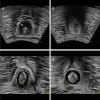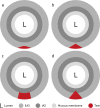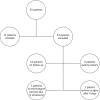Obstetric anal sphincter injuries (OASIS): using transperineal ultrasound (TPUS) for detecting, visualizing and monitoring the healing process
- PMID: 35948903
- PMCID: PMC9364618
- DOI: 10.1186/s12905-022-01915-7
Obstetric anal sphincter injuries (OASIS): using transperineal ultrasound (TPUS) for detecting, visualizing and monitoring the healing process
Abstract
Purpose: The aim of this study was to examine whether OASIS, and its extent, can be confirmed or excluded using transperineal ultrasound (TPUS). A further objective of this study was to monitor the healing process over a period of 6 months and to establish a connection between the sonographic appearance of obstetric anal sphincter injury (OASIS) and anal incontinence.
Materials and methods: In this retrospective clinical study, women with OASIS who gave birth between March 2014 and August 2019 were enrolled. All the patients underwent TPUS 3 days and 6 months after delivery. A GE E8 Voluson ultrasound system with a 3.5-5 MHz ultrasound probe was used. The ultrasound images showed a third-degree injury, with the measurement of the width of the tear and its extent (superficial, partial, complete, EAS and IAS involvement). A positive contraction effect, a sign of sufficient contraction, was documented. Six months after delivery, a sonographic assessment of the healing (healed, scar or still fully present) was performed. A Wexner score was obtained from each patient. The patients' medical histories, including age, parity, episiotomy and child's weight, were added.
Results: Thirty-one of the 55 recruited patients were included in the statistical evaluation. Three patients were excluded from the statistical evaluation because OASIS was excluded on TPUS 3 days after delivery. One patient underwent revision surgery for anal incontinence and an inadequately repaired anal sphincter injury, as shown sonographic assessment, 9 days after delivery. Twenty patients were excluded for other reasons. The results suggest that a tear that appears smaller (in mm) after 3 days implies better healing after 6 months. This effect was statistically significant, with a significance level of alpha = 5% (p = 0.0328). Regarding anal incontinence, women who received an episiotomy had fewer anal incontinence symptoms after 6 months. The effect of episiotomy was statistically significant, with a significance level of alpha = 5% (p = 0.0367).
Conclusion: TPUS is an accessible, non-invasive method for detecting, quantifying, following-up and monitoring OASIS in patients with third-degree perineal tears. The width, as obtained by sonography, is important with regard to the healing of OASIS. A mediolateral episiotomy seems to prevent anal incontinence after 6 months.
Keywords: Anal sphincter injuries; Obstetric anal sphincter injury; Third-degree perineal tear; Transperineal ultrasound.
© 2022. The Author(s).
Conflict of interest statement
The authors declare that they have no competing interests.
Figures




Similar articles
-
Is there a role for transperineal ultrasound imaging of the anal sphincter immediately after primary repair of third degree tears?Eur J Obstet Gynecol Reprod Biol. 2022 Apr;271:260-264. doi: 10.1016/j.ejogrb.2022.02.182. Epub 2022 Mar 2. Eur J Obstet Gynecol Reprod Biol. 2022. PMID: 35255362
-
Can transperineal ultrasound improve the diagnosis of obstetric anal sphincter injuries?Int Urogynecol J. 2022 Oct;33(10):2809-2814. doi: 10.1007/s00192-022-05290-7. Epub 2022 Aug 2. Int Urogynecol J. 2022. PMID: 35916899
-
[Definition, epidemiology and risk factors of obstetric anal sphincter injuries: CNGOF Perineal Prevention and Protection in Obstetrics Guidelines].Gynecol Obstet Fertil Senol. 2018 Dec;46(12):913-921. doi: 10.1016/j.gofs.2018.10.028. Epub 2018 Oct 29. Gynecol Obstet Fertil Senol. 2018. PMID: 30385355 Review. French.
-
Screening occult anal sphincter injuries in primigravid women after vaginal delivery with transperineal use of vaginal probe: a prospective, randomized controlled trial.Arch Gynecol Obstet. 2015 Oct;292(4):853-9. doi: 10.1007/s00404-015-3708-z. Epub 2015 Apr 10. Arch Gynecol Obstet. 2015. PMID: 25859828 Clinical Trial.
-
[Perineal tears and episiotomy: Surgical procedure - CNGOF perineal prevention and protection in obstetrics guidelines].Gynecol Obstet Fertil Senol. 2018 Dec;46(12):948-967. doi: 10.1016/j.gofs.2018.10.024. Epub 2018 Nov 2. Gynecol Obstet Fertil Senol. 2018. PMID: 30392991 Review. French.
Cited by
-
Martius fat pad flap procedure for management of obstetric rectovaginal fistula: A case report.Case Rep Womens Health. 2023 Sep 21;39:e00547. doi: 10.1016/j.crwh.2023.e00547. eCollection 2023 Sep. Case Rep Womens Health. 2023. PMID: 37781448 Free PMC article.
-
Perspective on Perinatal Birth Canal Injuries: An Analysis of Risk Factors, Injury Mechanisms, Treatment Methods, and Patients' Quality of Life: A Literature Review.J Clin Med. 2025 May 20;14(10):3583. doi: 10.3390/jcm14103583. J Clin Med. 2025. PMID: 40429577 Free PMC article. Review.
-
Three-Dimensional Transperineal Ultrasound Guiding Early Secondary Repair of Obstetric Anal Sphincter Injury in an Incontinent Patient without Suture Dehiscence.Diagnostics (Basel). 2023 Dec 27;14(1):68. doi: 10.3390/diagnostics14010068. Diagnostics (Basel). 2023. PMID: 38201377 Free PMC article.
References
-
- Deutsche Gesellschaft für Gynäkologie und Geburtshilfe. Leitlinie zum Management von Dammrissen III. und IV. Grades nach vaginaler Geburt. https://www.awmf.org/uploads/tx_szleitlinien/015-079l_S2k_Dammriss-III-I....
-
- Schumpelick V, Rath W, Willis S, Faridi A. Anale Inkontinenz nach vaginaler Geburt: Ein Argument für den Kaiserschnitt auf Wunsch ? Deutsches Ärzteblatt. 2002;99:1–2.
MeSH terms
LinkOut - more resources
Full Text Sources
Medical

